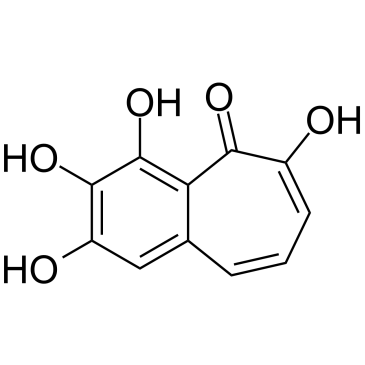Purpurogallin (Synonyms: NCI 35676, NSC 35676, NSC 646653) |
| Catalog No.GC38116 |
La purpurogalline est un phénol naturellement extrait des plantes de Quercus spp. Elle possède une puissante activité inhibitrice de la xanthine oxydase (XO) avec une IC50 de 0,2 μM.
Products are for research use only. Not for human use. We do not sell to patients.

Cas No.: 569-77-7
Sample solution is provided at 25 µL, 10mM.
Purpurogallin is a naturally phenol extracted from the plants of Quercus spp, has potent xanthine oxidase (XO) inhibitory activity with an IC50 of 0.2 µM. Purpurogallin has antioxidant and anti-inflammatory effects[1][2][3].
Purpurogallin (50 or 100 µM; 7 or 25 hours; BV2 murine microglial cells) treatment attenuates the production of pro-inflammatory cytokines, including interleukin-1β (IL-1β) and tumor necrosis factor-α (TNF-α) by suppressing their mRNA and protein expression in LPS-stimulated BV2 microglial cells[1].Purpurogallin (100 µM; 75-120 minutes; BV2 murine microglial cells) exhibits anti-inflammatory properties by suppressing the phosphatidylinositol 3-kinase/Akt and mitogen-activated protein kinase signaling pathways in LPS-stimulated BV2 microglial cells[1]. RT-PCR[1] Cell Line: BV2 murine microglial cells
Purpurogallin (100-400 μg/kg; intraperitoneal injection; for 48 or 72 hours; male Sprague-Dawley rats) exerts its neuroinflammation effect through the dual effect of inhibiting IL-6 and TNF-α mRNA expression and reducing HMGB1 protein and mRNA expression[2]. Animal Model: Fifty-four male Sprague-Dawley rats (250-350 g) with subarachnoid hemorrhage (SAH)[2]
[1]. Park HY, et al. Purpurogallin exerts anti?inflammatory effects in lipopolysaccharide?stimulated BV2 microglial cells through the inactivation of the NF?κB and MAPK signaling pathways. Int J Mol Med. 2013 Nov;32(5):1171-8. [2]. Chang CZ, et al. Purpurogallin, a natural phenol, attenuates high-mobility group box 1 in subarachnoid hemorrhage induced vasospasm in a rat model. Int J Vasc Med. 2014;2014:254270. [3]. Honda S, et al. Conversion to purpurogallin, a key step in the mechanism of the potent xanthine oxidase inhibitory activity of pyrogallol. Free Radic Biol Med. 2017 May;106:228-235.
Average Rating: 5 (Based on Reviews and 31 reference(s) in Google Scholar.)
GLPBIO products are for RESEARCH USE ONLY. Please make sure your review or question is research based.
Required fields are marked with *




















